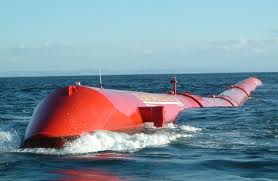It was just about a decade ago that I gave the Anton Bruun (left) Memorial Lecture in Paris on "Energy from the Sea" to the United Nations Educational, Scientific and Cultural Organization. Sad to say, but nothing much has changed.
A Renewable Energy World issue of 26December2012 headlined:
The article tried to be as optimistic as possible, but I can only shake my head, not up and down, but sideways, for the reality is that the commercialization of ocean energy seems not to be happening. Secondly, the only two marine options touted were wave and tidal power.
Wave energy can show some activity because it is like a car, somewhat affordable. There can be, of course, those perfect coastline and wave conditions to make several megawatts cost effective. However, I've long felt that this option, said to be as high as 2 tera watts, has marginal hope because the next great storm could well destroy the facility. If you attempt to beef the system for 100-year conditions, then the cost becomes prohibitive. A few failed demonstrations were discouraging. I have particular qualms about this pathway because one of my friends died doing consulting for this effort in Fiji.
There are more than 20 projects in various stages of development, and my sense is that Scotland and the state of Oregon seem to be ahead of the curve. The Scottish Pelamis effort is to the left. If you wish further details, click on my UNESCO paper.
Tidal power is showing recent movement, but, again, only if you have large tides and adequate estuary conditions. The 240 MW Rance Tidal Power Plant in France was commissioned in 1966, and, while still operating, strange that this was their first and last attempt. South Korea recently succeeded with the Sihwa Lake 254 Tidal Power Station. Next, the 1,320 MW (this is larger than the typical nuclear power plant) Incheon station should be completed around 2017 at a cost of $3.4 billion. Most of the sites are along the western coastline, for tides are in the 30 foot range, and production up to 6648 MW is being planned by 2020.
Tidal power for the Canada Bay of Fundy region has been kicking around forever, as tides as high as 53 feet can be measured. There is the 18 MW Annapolis Royal Generating Station, but environmental and economic concerns, seem to be retarding progress. You would think that environmentalists would cheer. Nope, bird lovers and fishermen are concerned.
I've of course been enamored with ocean thermal energy conversion (OTEC--above red areas are ideal) for more than a third of a century. I should indicate a kind of disclaimer, for I helped write the first OTEC bill when I went to work for the U.S. Senate in 1979. The problem with this technology is that 100 MW and larger commercial facilities will be very expensive. The financing of this option is awaiting success. Yet, the prospect are intriguing.
The beauty of OTEC is that while all the other marine non-bio technology options only generate electricity, OTEC provides electricity, freshwater, a cornucopia of co-products, next generation habitats and hydrogen/ammonia/biofuels, while showing potential for remediating global warming and preventing the formation of hurricanes. Blue Revolution Hawaii has advanced the Pacific International Ocean Station as the next phase of development, as the follow-on at-sea stage initiated by the Natural Energy Laboratory of Hawaii Authority (NELHA) on land.
A well-attended OTEC Summit involving industry and government was held at NELHA a little more than a year ago. Then, I participated in a panel with the most eminent scientists/engineers--Desikan Bharathan and Luis Vega--at the recent American Solar Energy Society gathering:
Dr. Bharathan is a senior scientist at the National Renewable Energy Laboratory, while Dr. Vega directs the Hawaii National Marine Renewable Energy Center.
 There are other ocean options, of course. Giant kelp, marine micro algae raceways, current power, and salinity gradient systems are being scrutinized. My Bruun lecture covered them all. If there is any interest, I'll review the biological options in the near future. For now, go to my HuffPo on Biofuels from Microalgae, and a nearly 40-year old newspaper article reporting on Howard Wilcox's methane from kelp farm.
There are other ocean options, of course. Giant kelp, marine micro algae raceways, current power, and salinity gradient systems are being scrutinized. My Bruun lecture covered them all. If there is any interest, I'll review the biological options in the near future. For now, go to my HuffPo on Biofuels from Microalgae, and a nearly 40-year old newspaper article reporting on Howard Wilcox's methane from kelp farm.The Blue Revolution, of course, combines OTEC with algae (micro and macro), next generation fisheries, floating cities and a range of other products in a manner that not only is in harmony with the marine environment, but, perhaps, too, enhansive, as reported in a paper our team presented in Singapore:
Additional details on the total system can be found in some of my HuffPo's:
-
























0 comments:
Post a Comment